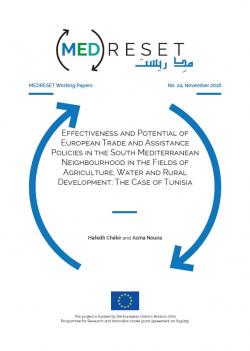Effectiveness and Potential of European Trade and Assistance Policies in the South Mediterranean Neighbourhood in the Fields of Agriculture, Water and Rural Development: The Case of Tunisia
This paper is part of a series of working papers to assess EU policies in the Southern and Eastern Mediterranean countries from a bottom-up perspective as part of the MEDRESET project. The focus of this paper will be on challenges and policies applied in the agriculture and water sectors in Tunisia. Special consideration will be given to the problems of international trade, particularly the Deep and Comprehensive Free Trade Agreement. The methodology used includes content analysis, literature review and face-to-face interviews with relevant local stakeholders in the agriculture and water sectors. In particular, the paper will provide the following: (i) a clear assessment of the problems and obstacles that are currently affecting the performance of the water and agriculture sectors, (ii) an outline of the national and EU policy actions in the sectors; (iii) a qualitative analysis of stakeholder frames in the area of agriculture and water based on 27 interviews; and lastly (iv) how EU policies in Tunisia may be improved or replaced according to the needs of the sector.
-
Details
Rome, IAI, November 2018, 29 p. -
In:
-
Issue
Working Paper 24
Introduction
1. Background Information on Tunisia
1.1 Agriculture and Water Profile
1.2 Main Policy and Legislative Issues and Developments in the Area of Agriculture and Water
1.2.1 National Level
1.2.2 International Level
2. Qualitative Analysis of Stakeholder Frames in the Area of Agriculture and Water
2.1 Methodology
2.2 Framing Agriculture and Water within a Broader Policy Context
2.3 Framing Agriculture- and Water-related Policy Challenges and Priorities
2.4 Evaluating the Effectiveness and Potential of EU Trade and Assistance Policies in Agriculture- and Water-related Sectors
Conclusion
References
Annex 1: Institutional Framework and Main Stakeholders Involved in Policy-Making
Annex 2: List of Interviewees
Annex 3: Questionnaire



